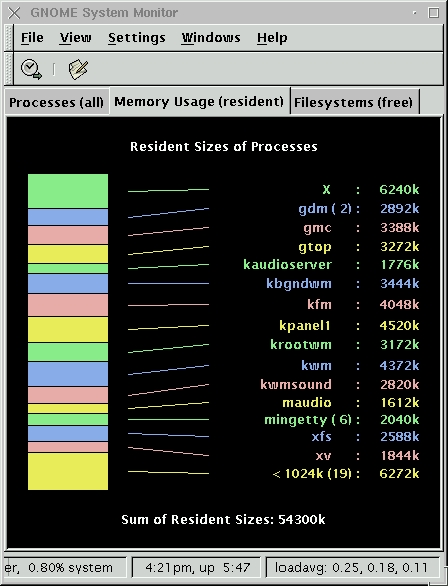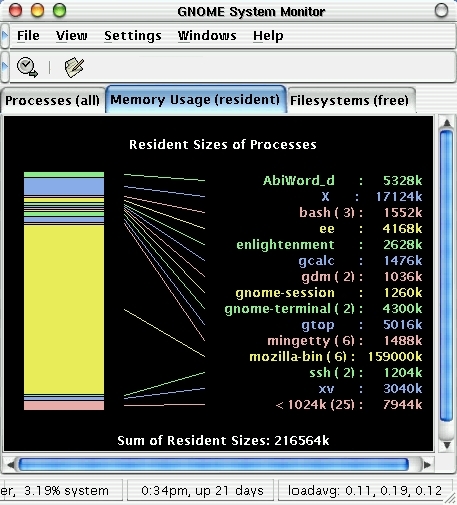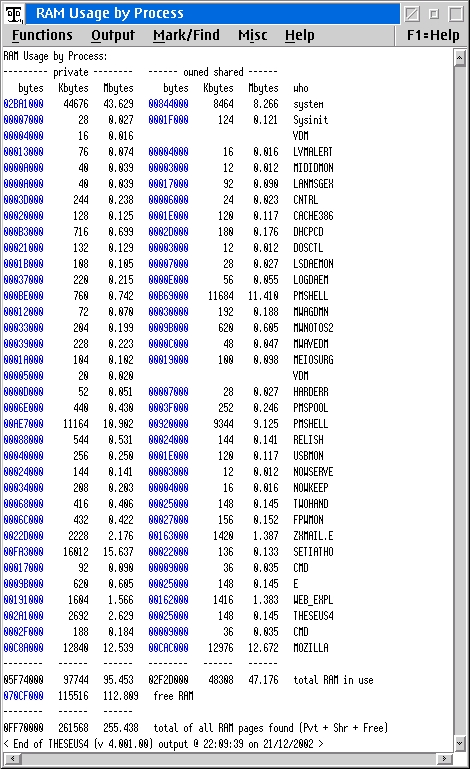
January 16, 2003
Isaac Leung got a degree in Engineering Physics and then Electrical Engineering after which he promptly got a job as a product engineer at a company which makes high speed datacom chips. He is old enough to have cut his computer teeth on Commodore 64's and first played with OS/2 1.3 EE while at a summer job with IBM. The first PC he ever owned came with Windows 95, but he soon slapped on OS/2 Warp 3 and has been Warping ever since. In his spare time, he plots to take over the world.
If you have a comment about the content of this article, please feel free to vent in the OS/2 eZine discussion forums.
There is also a Printer Friendly version of this page.
|
Previous Article |
|
Next Article |

Settling for OS/2?
It seems to me that in the past little while, there has been the attitude in the OS/2 community that "well, it works for me, so why move to another platform?" It sounds kind of harmless but (at least to me), it seems to imply that OS/2 is somehow "behind" and we are somehow justifying staying with an inferior operating system.
Hmm...let's take a quick run at this. If I were starting all over again today, would I still choose OS/2?
Full disclosure: I've been dabbling with computers since the old Commodore64/Apple ][ days. Used everything up to old VAX machines and IBM mainframes. Recently, I have used IRIX, AIX, HP-UX for many years, and Solaris, Windows, Linux, Mac and OS/2 are pretty much daily fare. So, it's not like I'm speaking as someone who hasn't seen the other side of the fence!
Technical Knock Out
The first thing I would do is compare all my choices from a technical standpoint. Now maybe the average user wouldn't do this, but it's still a reasonable first step to see if we can rule out OS/2 as a possible choice.OS/2 is a 32-bit, multi-tasking, multi-threaded operating system complete with a graphical user interface. That covers most of the important buzzwords, and it doesn't seem to be a step behind any of the current operating systems. No knockout yet, so let's look closer.
Most of you probably aren't experts in operating system design (and I'm certainly not saying that I am), but the implementation of OS/2 is still among the best in many ways. For example, take a look at this article from IBM, as an IBM developer describes what needs to be considered when porting from OS/2 to Linux. You may not understand the details, but I think most people will get the sense that in terms of threads, memory handling, queues, semaphores, etc. OS/2 still has the upper hand over Linux in it's capability and ease of use (for the programmer).
Yes, I know, one example is hardly sufficient proof, but we don't have time to go into all the nitty gritty details. I think this one article does highlight the fact that the core of OS/2 was actually very well planned and implemented.
Does OS/2 have any weaknesses? Sure, any platform does.I think the only big technical issue is that a lot of people have griped about OS/2's SIQ (Single Input Queue) problem. (And perhaps rightfully so, as WinNT and up don't have this problem. However, they got around this issue by not considering the issue of backward compatibility, which is one reason why OS/2 kept the SIQ through its various revisions.) If you're not familiar with this issue, what happens is that OS/2 only has one line of input from the user. If an application goes bad and cannot process the input, your system is effectively "crashed." (Well, not really, because everything continues to run in the background, so if you're running a server, you wouldn't even know.)
However, to be realistic, since way back when I installed MCP1, SIQ lockups are pretty rare on my machine. Certainly no more often than when Windows XP hangs on me, or X locks up in Linux. (The X-Window system locking up is the same issue as OS/2's SIQ. The system may not have crashed, but if you can't interact with it, or if you kill X and lose your work, that's pretty much the same effect.)
Every platform has its strengths and weaknesses, but on average, OS/2 multi-tasks and performs as well as, or even better than, any other desktop operating out there. But then, you already knew that, didn't you?
File Systems
I deliberately left this as a separate discussion, even though it is quite short, because OS/2 supports Installable File Systems (IFS). What this basically means is that we can "plug in" just about any file system we want and use it with OS/2. Whatever the best of the day is, there's no reason it can't be ported and used for OS/2. Nice, nice design!What about existing file systems? Of course, it comes with HPFS. Though old, HPFS, does excel in one area. In my experience, it is unmatched in the area of disk fragmentation. That is, it hardly fragments at all! Have you ever wondered why OS/2 doesn't come with a defragger? It's basically unnecessary! HPFS resists fragmentation better than any recent operating system I've used. By a wide margin. When it comes to performance, I'm not sure if anyone has done any benchmarks, but I doubt anyone has perceived their average OS/2 disk operations to be noticeably slower than any other system. No problem there!
With JFS, OS/2 got an advanced journalling filesystem. Industrial strength and most importantly, production ready, and has been for a while. OS/2 is leading the pack here and everyone is playing catch up. An interesting tidbit, in an interview (published on-line) with one of the developers at IBM, he stated that while the JFS from OS/2 used some code from the AIX JFS, it was essentially a new and improved implementation. Oh, and actually OS/2 does come with a defragger. Look in C:\OS2 for DEFRAGFS.EXE. This is for JFS only, because it is much more susceptible to fragmentation than HPFS.
Cost and Requirements
The best operating system in the world is no good if it costs you too much, both in terms of initial cost and hardware requirements.Fortunately, OS/2 comes in on the low end of the scale here. Honestly! For a new license of OS/2 (which you can still purchase from IBM Passport Advantage), the cost is pretty much in line with other commercial operating systems. It's hard to beat the $0 cost of Linux, but OS/2 makes up for that in hardware requirements.
Everyone already knows Windows XP is a resource hog. That's no secret, the minimum and suggested requirements for it are publicly posted by Microsoft. So, what about Linux, which is "free"? Because it isn't! Let's assume you have downloaded Linux and everything installed perfectly (so it didn't cost you a dime in media or your time.) Linux is resource hungry. Yes, you heard me right. Linux by itself, plain commandline is light. But nobody uses it like that on the desktop. Add in the latest KDE or GNOME, and you're looking at pretty hefty requirements. The desktop Celeron-400 which runs Linux in my lab is a lot slower than my PII-300 laptop running OS/2.
Don't believe me? Check this out:

This is a RedHat 7.2 system that is regularly kept up to date. I logged in using KDE after a clean reboot. With nothing loaded, it is already 54MB used. GNOME gets worse, especially if you use Nautilus (the only way to even approach the features of PMSHELL+WPS). That weighs in at about 125MB. In contrast, I'm running my OS/2 machine, typing this up, with a web browser loaded, and I chew up only 34MB. It only goes downhill for Linux from there. If I want to fire up Mozilla...

That's right. 216MB with nothing but Mozilla and I've not even begun to work yet. Remember, this is a clean reboot of the Linux machine, with Mozilla 1.1, not beta, freshly loaded and not loading a single page. (Why so much is chewed up, I don't know). With Mozilla/2, my OS/2 system is up to about 90MB used now.

Honestly, this is an un-retouched screencapture of Theseus. OS/2 is up, I'm working, I have Relish and IBM Works reminders running in the background. SETI@HOME is up, I even have ZxMail mail server running!
[Note: I should explain how I added up the OS/2 numbers. I just took the Shared total and added up also the Private memory for Mozilla and SETI@HOME, which eat quite a bit, and isn't really relevant to our discussion of base OS/2, but anyhow. You might notice it still doesn't quite add up, as the rest of the system has a large amount of Private memory tied up. Most of this is OS/2 doing it's thing, that is, loading up all the DLL's in its path, in case it needs them, not because it needs them. As memory is needed, unused ones will get swapped out to disk, and you won't even notice it happening. The summary, that stuff is actually free available for use, unless you open up every possible application and do every possible action in OS/2! Feel free to debate the actual numbers, but the end result is the same. OS/2 is not very memory hungry at all.]
So this is where it's all costing you. Even if you spent an extra $200 for OS/2, it sure doesn't seem that much now when you figure out you need a bigger hard drive, more memory and faster CPU to get the same job done! It's not hard to eat up $200 real fast on hardware.
Okay, so I lied. It's not even the same. For example, just try pulling up GNOME+Nautilus. Use the file manager to drag 'n drop a file to the desktop. Now go to the command-line and re-name that file. Double-click the desktop icon. Sorry! Can't find the file! (Even if you selected "Link" when you drag 'n dropped). Now do the same thing with OS/2. No matter what you rename it or where you move the file from the command line, the WPS+PMSHELL knows exactly where the file is. Try the same trick with Windows. Anything short of Windows XP won't work. Microsoft finally gets this right, but it just goes to show how far ahead OS/2 was, and still is.
Still the winner
If it sounds like I'm biased, well maybe I am! But only because I've taken a close look at the matter and have decided that OS/2 is still at or near the top as a general purpose desktop operating system. It would be stretching the truth to toss OS/2 based on purely technical reasons.Not only is it reliable, pleasant to use, easy to administer/maintain for the average user (unlike Linux or FreeBSD), but you can see it is also cost effective.
For sure there are some tasks where OS/2 is not up to the job (i.e. video editing or games), but that is more a problem with lack of application than base operating system shortcomings. (I seem to recall a time when some thought OS/2 wasn't capable of good video. Warpvision proved that all wrong!)
Some of you may be worried that IBM is totally abandoning OS/2. Maybe you're right, but first read these recent articles:
- Extreme Tech: OS/2 Alive and Well
- C|Net: OS/2 still sold here
- ZDNet: IBM says it won't give up on OS/2
The recent spate of withdrawal announcements is just the phasing out of shrink-wrapped packages. IBM publicly states that they're going to support OS/2 indefinitely. Assuming there are still customers, of course, which there are.
The cynical amongst you may point out that supporting OS/2 as always means nothing at all, and that there is still no way to report bugs or ask for new features. Well, let me ask you: Does OS/2 still work well, as well as Windows or Linux? How does one go about requesting new features or reporting bugs for Windows or Linux? Good or bad, OS/2 is on equal footing!
I'm not religiously tied to OS/2 in any way. I'm ready to jump ship as soon as a superior alternative comes along. But I'm still on the OS/2 boat because I've considered and tried all the alternatives (in fact, continue to use daily!), and I think it's still the best one here. I'm not on OS/2 because I'm too lazy to move. It's my secret competitive advantage!
Addendum
Originally, I was also going to talk about all the applications OS/2 still has (afterall, the best operating system in the world is no good without applications), that are more than adequate for even power users. But I scrapped that. I'm going to try and do one better! In addition to the usual software reviews, I'm going to do as many "how-to" articles as possible, so that OS/2 users will realize what you can do (easily!) with what we already have! It's not going to be hypothetical, each will be based on a real task that I have to do on the job, starting this month with numbering in Lotus SmartSuite.|
Previous Article |
|
Next Article |